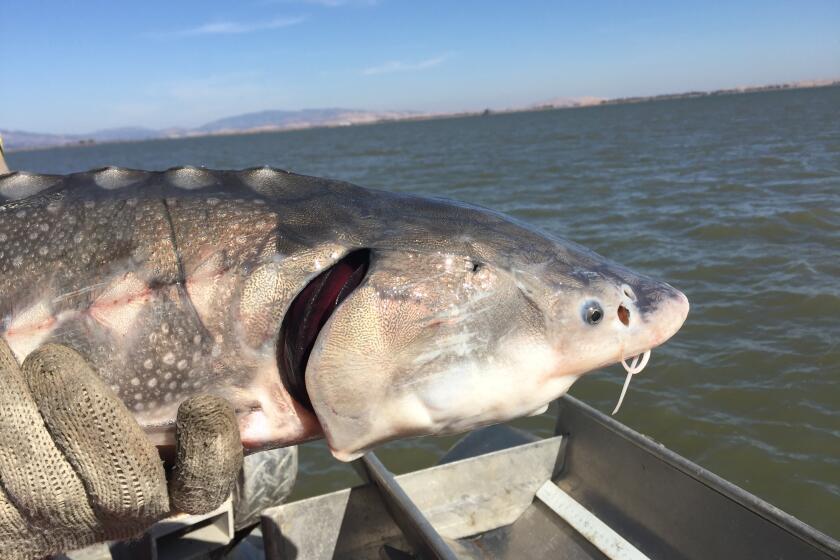Strawberries Under Suspicion : Officials Looking Into Reports of Illness Caused by Parasite
California strawberries are being cited as the possible source of a parasite that has sickened dozens of people in Texas, prompting concern among some growers here that the reports might lead to a drop in sales.
Although federal health inspectors have yet to confirm a specific cause, Texas health officials said they believe the strawberries may be the link to more than 100 confirmed or suspected cases of the parasite-related illness in the Houston area.
The state’s shipments to Houston have fallen off in recent weeks in the wake of the reports, which began appearing in May in Texas, and California growers said they are concerned that orders elsewhere could decline. California growers produce 80% of the fresh and frozen strawberries consumed nationwide.
“People have cut back on ordering strawberries, but they haven’t shut the door entirely,” said Nick Pasculli, president of Naturipe Berry Growers in Watsonville. “If this [bad publicity] creates a stigma, it could have an effect that is unfair to the industry.”
The Houston cases are part of an outbreak in nine states caused by the organism cyclospora. Federal officials say hundreds of cyclospora-related cases have been reported since May. Epidemiologists in Houston identified California strawberries as the likely source. About 70 people in Toronto were reportedly stricken, and officials in Ontario have advised people to wash U.S. strawberries. No deaths have been reported.
The organism can cause severe diarrhea, stomach cramps, nausea, vomiting and extreme fatigue. The symptoms can last for several weeks. The illness can be treated by antibiotics.
California health officials said Friday that no cyclospora cases have been reported in the state. The Department of Health Services said initial tests have not turned up any evidence of the parasite in California strawberries and that no major hospitals have reported any instances of illness caused by the organism.
The national Centers for Disease Control, which dispatched an epidemiologist to Houston on Friday to check out the reports there, plans to issue a report on its findings next week, a spokesman said.
Meanwhile, investigators from the Food and Drug Administration are trying to pin down whether the parasite is being transmitted through food.
Teresa Thorne, spokeswoman for the California Strawberry Commission, said the trade group is working with government investigators to help them track down the parasite’s origin. However, she said California’s climate isn’t generally conducive to the parasite’s growth.
“The way we grow strawberries is not consistent with the hot, humid conditions that the parasite generally thrives in,” she said.
Growers all over the state produce the bulk of the nation’s strawberries. However, because the growing seasons vary by latitude, growers in Central California, the state’s chief strawberry-growing region, would have the most to lose this year. Farmers there have struggled through two rough business years and have been counting on sales through September to make this a profitable year, sources say.
Strawberry growers in Southern California have less to fear than their counterparts to the north. The season for fresh strawberries here is almost over--the berries being picked now are mainly for use in jellies, jams and ice cream.
Though some retailers have trimmed back on orders of California strawberries, there hasn’t been a nationwide drop.
John White, produce director at Mother’s Market & Kitchen Inc. in Costa Mesa, says he’s heard customers say they might buy raspberries instead of strawberries until health authorities can pinpoint the source of the outbreak.
However, White says the grocer’s strawberry sales haven’t actually declined. After checking with government health authorities, White said, he’s continuing to stock California berries.
Associated Press contributed to this report.
(BEGIN TEXT OF INFOBOX / INFOGRAPHIC)
Spotlight on Strawberries
Although Texas health officials said they have definitively linked outbreaks of the parasite cyclospora to strawberries grown in California, Centers for Disease Control and Prevention officials and state epidemiologists caution they have yet to make a connection between the fruit and the parasite. California strawberry growers--who produce 80% of the country’s fruit--are concerned the link may chill berry sales:
The infections: The first cases of cyclospora infection this year were reported in May in Houston. Since then, infections have been found in eight states, including New York, Ohio and South Carolina, as well as in Toronto. Last year there was an outbreak in Boca Raton, Fla. The source of the organism in that outbreak was never confirmed.
The transmitter: Health officials linked the parasite to berries after interviewing those who became ill about their eating habits and finding many had eaten strawberries or raspberries.
The parasite: Cyclospora are single-cell organisms that are too small to be seen without a microscope. The organism is thought to have originated in New Guinea and has been discovered in the U.S. only in the past decade.
Cyclospora cayetanenis: Because it is newly recognized infectious organism, many questions remain about the ways it is transmitted and the illnesses that it causes, according to the CDC.
Symptoms: Cyclospora enter a person’s system after they eat or drink something contaminated with the parasite. Infection causes diarrhea, vomiting, nausea, low-grade fever and fatigue.
Precautions: Although officials in Houston, Toronto and New Jersey have urged residents not to eat fresh California strawberries, the CDC has not issued any recommendations against eating them.
How it contaminates food: Cyclospora, like its cousin cryptosporidium that caused 100 deaths and made about 400,000 ill after it contaminated Milwaukee’s drinking water supply in 1993, can live in fecal matter, dirt and water. While cryptosporidium is immediately infectious, cyclospora are not infectious for five to seven days. Moisture or temperatures of at least 77 degrees are required to allow the parasite to mature into an infectious state.
The link may be problematic: Some epidemiologists are skeptical about the strawberry/cyclospora link, saying they do not understand how the berries, which are grown on mounds high above the ground and are not soaked in water, could become contaminated. In addition, although the disease is being blamed on California strawberries, there have been no cases reported in California.
Washing the fruit: If the cyclospora organism is under the skin of the fruit, washing won’t help. Some health officials say that with the water-loving cyclospora, washing may even make things worse.
Big Business
Strawberries, which yielded $608 million for California farmers last year, fell to 10th on a list of the state’s most lucrative crops in 1994.
During the strawberry season--which typically runs from mid-May into July--producers ship up to 5 million trays a week to market.
The state’s leading strawberry-producing counties are, in order: Monterey, Ventura, Santa Cruz, Santa Barbara and Orange.
Top 10 crops produced in California in 1994
Crop: Value (billions)
1. Milk and cream: $2.9
2. Grapes (table, wine and raisin): $1.6
3. Cattle and calves: $1.4
4. Nursery products: $1.3
5. Cotton lint: $1.1
6. Almonds: $0.9
7. Hay: $0.9
8. Flowers and foliage: $0.7
9. Processing tomatoes: $0.7
10. Strawberries: $0.6
Sources: California Farm Bureau; Professor Lawrence Ash, UCLA School of Public Health; Associated Press; Times and wire reports. Researched by JENNIFER OLDHAM / Los Angeles Times
More to Read
Start your day right
Sign up for Essential California for news, features and recommendations from the L.A. Times and beyond in your inbox six days a week.
You may occasionally receive promotional content from the Los Angeles Times.






